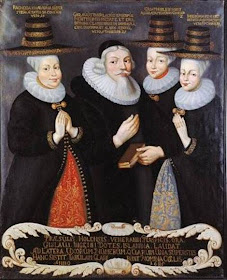The embroiderer is Ragnheiður Jónsdóttir and you can see more of her on the front of the note together with her husband, a bishop. The source for the image is a portrait made in 1636 in Copenhagen.



 There is a semaphore of costume which you probably have to be a Marker native to interpret. It was habitual for the younger girls to have their bodices laced at the back, and they wore a decorative chintz bib over their front. When the girls were about 14 or so - courting age - the custom was to change the bodice around and have it laced from the front... When the girl is 16 or 17, the back of her hair is cut short, leaving just the long pipe curls on each side of her face. Her flowered cap is replaced by a white one. This beautiful girl may be a newly-wed.
There is a semaphore of costume which you probably have to be a Marker native to interpret. It was habitual for the younger girls to have their bodices laced at the back, and they wore a decorative chintz bib over their front. When the girls were about 14 or so - courting age - the custom was to change the bodice around and have it laced from the front... When the girl is 16 or 17, the back of her hair is cut short, leaving just the long pipe curls on each side of her face. Her flowered cap is replaced by a white one. This beautiful girl may be a newly-wed.